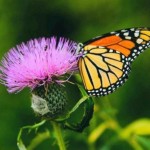
A growing number of Louisiana gardeners are planting butterfly plants to create a natural habitat that attracts these magical creatures. Growing butterfly plants in pots or in the ground around patios is a great hobby for homeowners as well as bed and breakfasts innkeepers who decorate their landscapes with these plants to the delight of their guests.
The life cycle of a butterfly is a truly fascinating occurrence. Beginning life as a caterpillar, these insects develop into beautiful and delicate butterflies. Once a butterfly, before winter, they must migrate south from many areas in the U.S., mostly to Mexico but also to Florida and California. How can a small, delicate butterfly travel that many miles?
The flight of butterflies, which has been occurring for thousands of years, is the longest known distance insect migration on earth. The beautiful monarch butterfly tends to be very popular and is easily recognizable. They have an extraordinary sense which helps them avoid large bodies of water and tall mountains, even though none of them have ever traveled that way before. One of the most amazing things about the monarchs flight from Canada to Mexico is that they fly south in a 50-mile wide distance between Eagle Pass, Texas and Del Rio, Texas. To save energy, they take advantage of thermal waves in the sky. They end their migration to roost in evergreen trees in only a dozen specific high mountain peaks in the Sierra Madre mountain rage in Central Mexico. Then, after several months, they return north, east and west where the females lay hundreds of eggs. Those eggs develop into caterpillars, then as pupa in its chrysalis, then finally emerge as a butterfly. This process takes about 4 weeks.
The only source of food for the monarch butterfly is the milkweed plant, poisonous to many animals but not to the monarch. Gulf fritillary or passion butterflies like passion vine or maypop. Your local nursery should be able to help you choose plants that will work in your garden or around your patio.
Want to learn more about butterflies and get started planting your butterfly garden? Read Butterfly Gardening for Louisianians by the LSU Ag Center.


